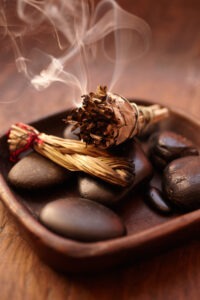
People often ask me “What is smudging.” To smudge is a method of energy clearing. The aim is to transmute negative energy from a space, object, or person.
Who Uses Smudge
The most common users of smudge are those who work with subtle energy and spirit. Shamans and energy workers typically remove negative energy from their space before conducting healing or spiritual work. This enhances the efficacy of their practices. They may also use one of several smudging methods to clear themselves and their clients.
More and more a wider range of practitioners such as massage therapists, acupuncturists, counselors, and the general public use smudge to clear and refresh their homes, offices, and other spaces. They may smudge themselves, but they don’t typically smudge their clients.
Traditional Smudging Methods
Throughout human history, many cultures used this ancient practice of smudging for spiritual and health purposes. Arguably, the smoldering dried herb stick is the most well-known smudging method.
Creating herb sticks is straightforward. People bunched and tied herbs and twigs tightly together into wands or sticks.
To use these bundled herbs, they lit them on fire. They then extinguished the flame, causing the sticks to smolder. This smoke was the cleansing agent. People passed the sticks over people and objects, covering them with smoke. They also used this smudging method in healing spaces and homes to purify and clear negative energies.
Common Clearing Herbs
White sage (Salvia apiana), sweetgrass (Hierochloe odorata), and sagebrush (Artemisia californica) are several of the most common herbs used in North America.
Adding Additional Healing Plants
People in India and Sri Lanka used Sandalwood (Santalum album) for centuries, typically in the form of incense. In the Middle East Frankincense (Boswellia cateri) resin is the traditional cleansing oil.
The downside to this type of clearing method is the burning creates smoke. These smoldering herbs can be overpowering and irritating. Hence, this method of smudging is not advised for people with allergies to smoke and respiratory issues. Fortunately, there are two other smudging methods.
Alternative Methods
Essential Oils
Diffuser oils made for high-quality essential oils can be added to a diffuser, volatilized, and dispersed into a space. This form of smudging can be applied continuously over some time by just leaving the diffuser running.
You can combine different essential oils with the basic clearing blend, creating a more complex and multipurpose blend. and specific healing effect. See Smudging: Creating a Clear and Protected Space, my natural healing and wellness eBook for ideas on additional essential oils to use.
Diffusion works well for practitioners who see many clients, one right after the other. It’s ideal for a busy spa, wellness center, or mental health practice.
Very light dilutions effectively express the medicinal properties: less is better. Just three or four drops of diffuser oil can adequately clear an average size room of 12 square feet.
Liquid Smudge
This liquid form is typically very light and exceptionally vibrational, especially when made from all-natural plant substances such as hydrosols. Because their scent is extremely light, there is little or no scent creep between healing sessions, making them ideal for spas, wellness centers, and offices.
For More Information:
See my Starchaser eBook Smudging: Setting a Clear and Protected Space. The book provides information on smudging, over 20 plants and essential oils that can reinforce or expand the intentions of the clearing, and descriptions of other methods of smudging.
Register for one of my in-person or virtual personal development, natural healing, and wellness workshops.
Updated July 19, 2024
